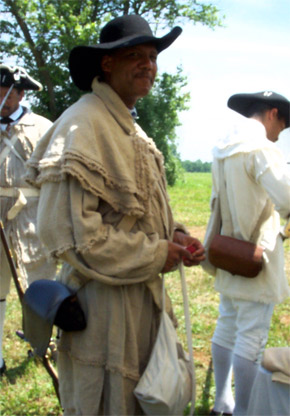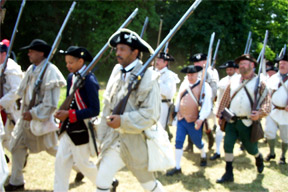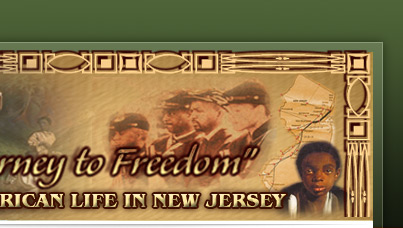 Colonel
Tye Colonel
Tye
One of the most famous Black Loyalists was
Colonel Tye, a runaway slave who joined the Ethiopian
Regiment and led the Black Brigade Partisan Group, a
band of guerilla soldiers, which conducted several successful
raids against the American Army in New Jersey throughout
the war. The New Jersey Gazette reported about one raid
led by Colonel Tye on June 9, 1780.
“Tye, with his party of about 20 blacks and whites,
took and carried off prisoner, Capt. Barnes. Smock and
(Lt.) Gilbert Van Mater. At the same time, (The Partisans)
spiked up the iron four pounder at Capt. Smock’s house,
but took no ammunition. Two of the artillery horses
were also taken. The above mentioned Tye is a Negro,
who wears the title of Colonel, and commands a motley
crew at Sandy Hook.”
http://www.pbs.org/wgbh/aia/part2/2p52.html
People & Events:
COLONEL TYE
(1753 – 1780)
Colonel Tye, the most feared and respected guerrilla
commander of the Revolution, was one of the many enslaved
Africans who escaped and fought for the British.
Known in his youth as Titus, he was one of four young
men owned by John Corlies of Shrewsbury, in the eastern
part of Monmouth County, New Jersey. Shrewsbury Quakers,
under increasing pressure from their Philadelphia-influenced
counterparts to the west, finally began to end slavery
among themselves in the 1760s. Corlies did not follow
the local practice of educating his slaves or of freeing
them on their 21st birthdays, and by 1775, he was one
of the few remaining Quaker slaveholders in Monmouth
County.
In November 1775, the day after Dunmore's Proclamation
was issued, 22-year old Titus fled from his cruel, quick-tempered
master, joining the flood of Monmouth County blacks
who sought refuge with the British as soldiers, sailors
and workers. Titus changed his name, gaining notoriety
three years later as Captain Tye, the pride of Dunmore's
Ethiopian Regiment.
While not formally commissioning black officers, the
British army often bestowed titles out of respect, and
Tye quickly earned their respect. In his first known
military incursion, the June, 1778 Battle of Monmouth
(in which not a single black from the county fought
for the patriots), Tye captured a captain in the Monmouth
militia.
In July, 1779, Tye's band launched a raid on Shrewsbury,
and carried away clothing, furniture, horses, cattle,
and two of the town's inhabitants. With his "motley
crew" of blacks and white refugees known as "cow-boys,"
Tye continued to attack and plunder patriot homes, using
his knowledge of Monmouth County's swamps, rivers and
inlets to strike suddenly and disappear quickly. These
raids, often aimed at former masters and their friends,
were a combination of banditry, reprisal, and commission;
Tye and his men were well-paid by the British, sometimes
earning five gold guineas.
During the harsh winter of 1779, Tye was among an elite
group of twenty-four black Loyalists, known as the Black
Brigade, who joined with the Queen's Rangers, a British
guerrilla unit, to protect New York City and to conduct
raids for food and fuel.
By 1780, Colonel Tye had become an important military
force. Within one week in June, he led three actions
in Monmouth County. On June 9, Tye and his men murdered
Joseph Murray, hated by the Loyalists for his summary
execution of captured Tories under a local vigilante
law. On June 12, while the British attacked Washington's
dwindling troops, Tye and his band launched a daring
attack on the home of Barnes Smock, capturing the militia
leader and twelve of his men, destroying their cannon,
depriving Washington of needed reinforcements, and striking
fear into the hearts of local patriots.
In response, Governor Livingston, who had tried two
years before to abolish slavery in New Jersey, invoked
martial law -- a measure which proved totally ineffective
-- even as large numbers of blacks, heartened by news
of Tye's feats, fled to British-held New York.
In a series of raids throughout the summer, Tye continued
to debilitate and demoralize the patriot forces. In
a single day, he and his band captured eight militiamen
(including the second in command), plundered their homes,
and took them to imprisonment in New York, virtually
undetected and without suffering a single casualty.
In September, 1780 Tye led a surprise attack on the
home of Captain Josiah Huddy, whom Loyalists had tried
to capture for years. Amazingly, Huddy and his friend
Lucretia Emmons managed to hold off their attackers
for two hours, until the Loyalists flushed them out
by setting the house afire. During the battle, Tye was
shot in the wrist, and days later, what was thought
to be minor wound turned fatal when lockjaw set in.
After Tye's death, Colonel Stephen Blucke of the Black
Pioneers replaced him as leader of the raiders, continuing
their attacks well after the British defeat at Yorktown.
Tye's reputation lived on, among his comrades as well
as the Patriots, who argued that the war would have
been won much sooner had Tye been enlisted on their
side.
http://www.pbs.org/wgbh/aia/part2/2h1.html

“CUDJO” ON THE MONMOUTH BATTLEFIELD
(JUNE 1778)
Cudjo, a Black man owned by Benjamin Coe, claimed to
be descended from royal African lineage. He served in
the Revolutionary War as a substitute for Coe and fought
valiantly at Monmouth Battlefield in June 1778 and,
it is believed, on other battlefields as well. When
Cudjo returned home, Coe gave him his freedom, a house
and an acre of ground on High Street.
The American Revolution:
 OLIVER
CROMWELL OLIVER
CROMWELL
Cromwell, Oliver, Black, Soldier, WSS:177 NJ. Oliver
Cromwell was, for six years and nine months, under the
immediate command of General George Washington, whom
he loved affectionately. His discharge at the close
of the war was in Washington’s own handwriting, of which
he was very proud, often speaking of it.
JACOB FRANCIS
Francis, Jacob. Black, Soldier, 2459 NJ. A 21-year-old
newly freed New Jersey slave found himself in Massachusetts
at the outbreak of war. Francis served over a year in
the Massachusetts Line, fighting at Long Island and
Trenton. When discharged, he returned to his home in
Amwell, New Jersey, and served numerous tours of active
duty in the militia until the cessation of hostilities.
The American Revolution:
“CESAR’S STORY” SCOTCH PLAINS BAPTIST CHURCH,
SCOTCH, NJ
(1747)
Cesar. Black, Teamster, WSS:860 NJ. A native of Guinea
Africa, Cesar was the first documented African in Plainfield.
He served as a wagoneer in the Revolutionary War while
in his 70s, brought supplies to soldiers at the Blue
Hills Fort and encampment. Church records show that
Cesar remained a faithful member of the Scotch Plains
Baptist Church in Scotch, New Jersey until he died at
the age of 104
PETER WILLIAMS
Williams, Peter. Black, Soldier and Wagoneer, RWPF W3638,
BLWt 67674-160-55, MD. Peter Williams, an African-American
slave living in New York City, was an expert cigar maker,
having learned the trade from his owner, a tobacco merchant.
Upon occupation of New York by the British, he fled
to New Jersey, settling in New Brunswick. There he lived
with a Patriot family, met and married his wife Molly,
and made his choice for independence. Peter Williams
laid the cornerstone for Zion in 1800, and established
the first African Methodist Episcopal Church in New
York City.
JACOB FRANCIS
A 21-year-old newly freed New Jersey slave found himself
in Massachusetts at the outbreak of war. Francis served
over a year in the Massachusetts Line, fighting at Long
Island and Trenton. When discharged, he returned to
his home in Amwell, New Jersey, and served numerous
tours of active duty in the militia until the cessation
of hostilities.
Select List of Black Revolutionary
War Participants, New Jersey
NEW JERSEY AFRICAN-AMERICAN SOLDIERS OF THE
REVOLUTIONARY WAR
The following names of New Jersey Black soldiers are
compiled from the National Archives list, Nell’s Colored
Patriots, Quarles “The Negro in the American Revolution.”
and Dann’s “The Revolution Remembered.” Each soldier
is identified as a private, unless otherwise noted.
- POMPEY BLACK, 2ND NEW JERSEY
- JAMES CASAR, 1ST NEW JERSEY
- JOHN CASAR, 1ST NEW JERSEY
- JOHN CATO, 4TH NEW JERSEY
- JOHN CEASAR, 4TH NEW JERSEY
- SAMUEL CHARLTON, NEW JERSEY LINE
- OLIVER CROMWELL, 2ND NEW JERSEY
- CUDJO (for his master Benjamin Coe), NEW
JERSEY LINE
- NEGRO CUFF (FIFER), 3RD NEW JERSEY
- PETER SALEM
- WILLIAM CUFFEY, 2ND NEW JERSEY
- JACOB FRANCIS, NEW JERSEY MILITIA/COL. PHILLIPS
- CATO JOHNSON SPENCER’S, ADDITIONAL REGIMENT
- JONATHAN CATO, 4TH NEW JERSEY
- DICK NEGRO, 1ST NEW JERSEY
- BLACK PRIME, 2ND NEW JERSEY
- NEGRO SAMBO, 4TH NEW JERSEY
- SAMUEL SUTPHIN, NEW JERSEY LINE
- NEGRO TITUS, 1ST NEW JERSEY
- AMOS TOMSON, 1ST REGT., BURLINGTON
- MILITIA/2ND NEW JERSEY
- PETER WILLIAMS, NEW JERSEY LINE
EDITED BY: RICHARD S. WALLING, 1994
|
